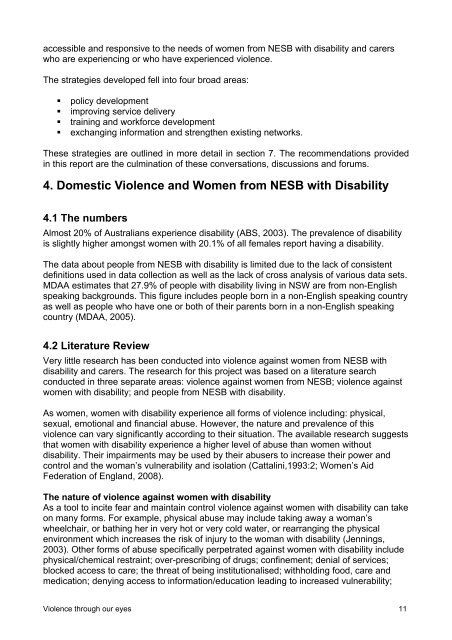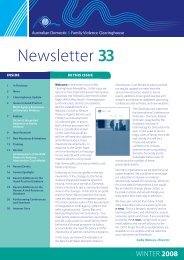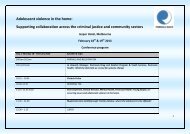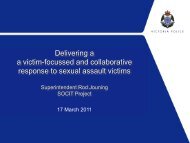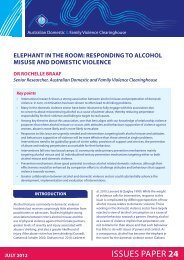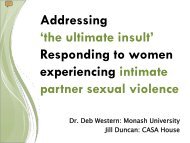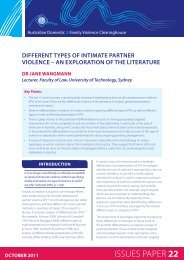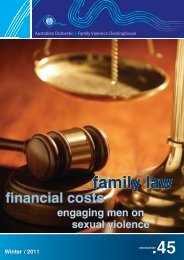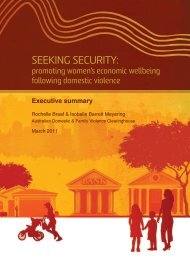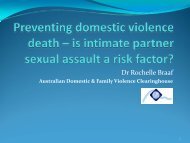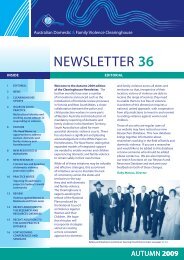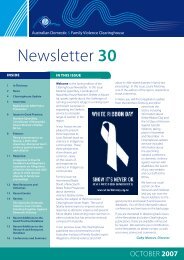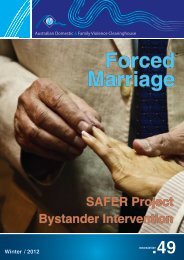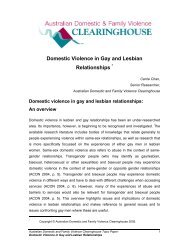Violence through our eyes - Women With Disabilities Australia
Violence through our eyes - Women With Disabilities Australia
Violence through our eyes - Women With Disabilities Australia
You also want an ePaper? Increase the reach of your titles
YUMPU automatically turns print PDFs into web optimized ePapers that Google loves.
accessible and responsive to the needs of women from NESB with disability and carers<br />
who are experiencing or who have experienced violence.<br />
The strategies developed fell into f<strong>our</strong> broad areas:<br />
• policy development<br />
• improving service delivery<br />
• training and workforce development<br />
• exchanging information and strengthen existing networks.<br />
These strategies are outlined in more detail in section 7. The recommendations provided<br />
in this report are the culmination of these conversations, discussions and forums.<br />
4. Domestic <strong>Violence</strong> and <strong>Women</strong> from NESB with Disability<br />
4.1 The numbers<br />
Almost 20% of <strong>Australia</strong>ns experience disability (ABS, 2003). The prevalence of disability<br />
is slightly higher amongst women with 20.1% of all females report having a disability.<br />
The data about people from NESB with disability is limited due to the lack of consistent<br />
definitions used in data collection as well as the lack of cross analysis of various data sets.<br />
MDAA estimates that 27.9% of people with disability living in NSW are from non-English<br />
speaking backgrounds. This figure includes people born in a non-English speaking country<br />
as well as people who have one or both of their parents born in a non-English speaking<br />
country (MDAA, 2005).<br />
4.2 Literature Review<br />
Very little research has been conducted into violence against women from NESB with<br />
disability and carers. The research for this project was based on a literature search<br />
conducted in three separate areas: violence against women from NESB; violence against<br />
women with disability; and people from NESB with disability.<br />
As women, women with disability experience all forms of violence including: physical,<br />
sexual, emotional and financial abuse. However, the nature and prevalence of this<br />
violence can vary significantly according to their situation. The available research suggests<br />
that women with disability experience a higher level of abuse than women without<br />
disability. Their impairments may be used by their abusers to increase their power and<br />
control and the woman’s vulnerability and isolation (Cattalini,1993:2; <strong>Women</strong>’s Aid<br />
Federation of England, 2008).<br />
The nature of violence against women with disability<br />
As a tool to incite fear and maintain control violence against women with disability can take<br />
on many forms. For example, physical abuse may include taking away a woman’s<br />
wheelchair, or bathing her in very hot or very cold water, or rearranging the physical<br />
environment which increases the risk of injury to the woman with disability (Jennings,<br />
2003). Other forms of abuse specifically perpetrated against women with disability include<br />
physical/chemical restraint; over-prescribing of drugs; confinement; denial of services;<br />
blocked access to care; the threat of being institutionalised; withholding food, care and<br />
medication; denying access to information/education leading to increased vulnerability;<br />
<strong>Violence</strong> <strong>through</strong> <strong>our</strong> <strong>eyes</strong> 11


